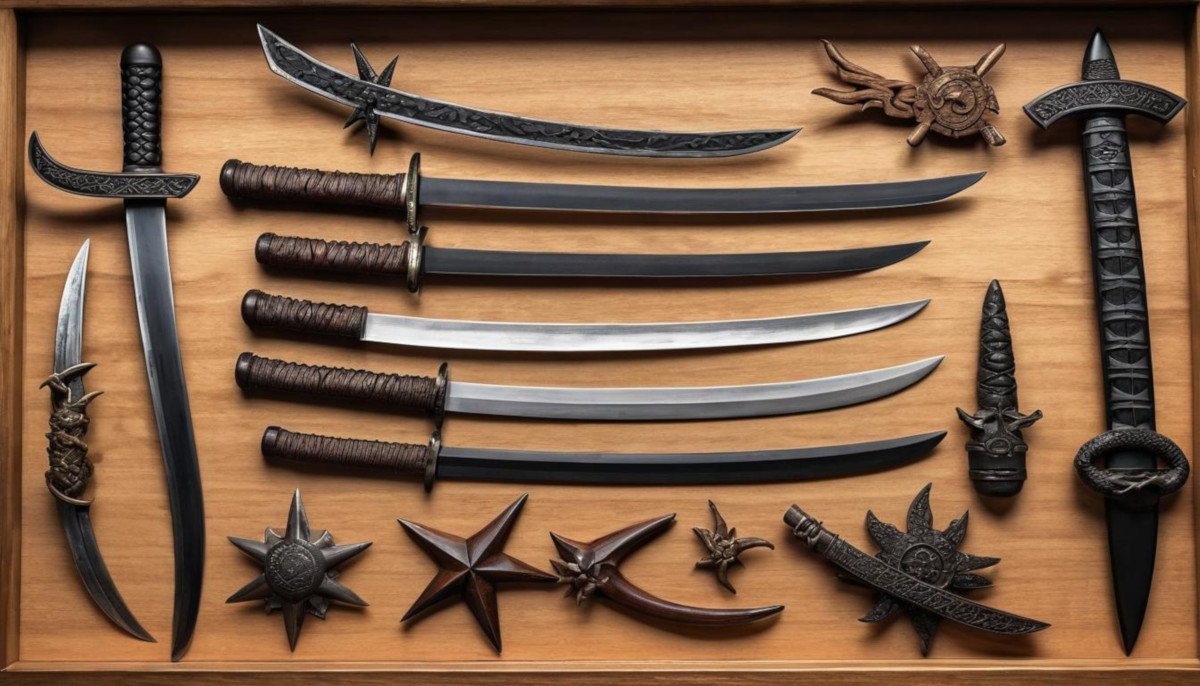The legacy of the ninja, shrouded in mystery and intrigue, has captivated imaginations across centuries. In popular culture, ninjas are often depicted as shadowy figures skilled in espionage, stealth, and combat. Central to their mystique are their weapons—tools designed not only for combat but for a variety of covert operations. This comprehensive article delves into the world of ninja weapons, exploring their history, functionality, and cultural significance.
The Historical Context of Ninja Weapons
1. The Origin of Ninjas
Ninjas, or “shinobi,” were covert agents in feudal Japan, primarily active during the Sengoku period (1467-1603). They were employed by samurai and feudal lords for espionage, sabotage, and guerrilla warfare. Unlike the samurai, who adhered to a strict code of honor, ninjas operated in secrecy, utilizing a range of specialized weapons and techniques.
2. The Evolution of Ninja Weapons
The weapons used by ninjas evolved in response to their tactical needs. Initially, their arsenal included traditional Japanese weapons adapted for stealth and versatility. Over time, these weapons were refined and specialized, incorporating unique design elements to enhance their effectiveness in various covert operations.
Categories of Ninja Weapons
Ninja weapons can be broadly categorized into several types based on their function and design. Each category reflects the strategic needs of the ninja and the challenges they faced in their missions.
1. Bladed Weapons
Bladed weapons were essential to the ninja’s arsenal, used for both offense and defense.
- Katana: Although more commonly associated with samurai, the katana was also used by ninjas. Its curved, single-edged blade allowed for quick, precise strikes. The katana’s design made it effective for close-quarters combat.
- Kunai: Originally a farming tool, the kunai was adapted by ninjas for combat and utility. Its versatility allowed it to be used as a dagger, throwing weapon, and even a tool for climbing.
- Shuriken: Often referred to as “throwing stars,” shuriken were small, star-shaped blades used for distraction and to inflict minor wounds. They were typically thrown with precision to disorient or incapacitate an opponent.
2. Blunt Weapons
Blunt weapons were used by ninjas to subdue opponents quietly or to break through defenses.
- Tanto: A small dagger with a fixed blade, the tanto was used for close combat and as a concealed weapon. Its size made it ideal for stealth operations.
- Bo Staff: A long wooden staff used for striking and blocking. The bo staff was versatile and could be wielded effectively in both offensive and defensive maneuvers.
- Nunchaku: Consisting of two connected sticks, the nunchaku was used for striking and entangling. It required skill and precision to master, making it a formidable weapon in the hands of a trained ninja.
3. Ranged Weapons
Ranged weapons allowed ninjas to engage enemies from a distance, enhancing their stealth capabilities.
- Blowgun: A tube used to fire small darts or pellets. The blowgun was used for delivering poisons or tranquilizers discreetly. Its silent operation made it ideal for covert missions.
- Yumi (Longbow): Though less common among ninjas, the yumi was sometimes used for long-range attacks. Its power and accuracy made it useful for striking targets from a distance.
- Fireworks and Explosives: Ninjas used small explosives and fireworks to create diversions or cause chaos. These tools were essential for disrupting enemy plans and facilitating escape.
4. Utility Tools
Utility tools were designed for practical use in various scenarios, from climbing to covert entry.
- Climbing Claws (Shuko): Metal claws worn on the hands or feet to assist in climbing walls or trees. Shuko provided traction and stability, allowing ninjas to scale surfaces with ease.
- Grappling Hook: A tool used for scaling walls or crossing obstacles. The grappling hook was essential for infiltration and escape.
- Smoke Bombs: Small devices that produced smoke to obscure vision and provide cover. Smoke bombs were used to create distractions and facilitate stealthy movements.
The Craftsmanship of Ninja Weapons
1. Traditional Materials
Ninja weapons were crafted from materials suited to their function and the conditions in which they would be used.
- Steel and Iron: High-quality steel and iron were used to forge bladed weapons like katanas and kunai. The durability and sharpness of these materials were crucial for effective combat.
- Wood: Wood was used for weapons like the bo staff and nunchaku. It was chosen for its availability and ease of shaping.
- Bamboo and Leather: Bamboo was used for lightweight weapons and tools, while leather was often used for grips and protective coverings.
2. Manufacturing Techniques
The manufacturing of ninja weapons involved traditional Japanese techniques that ensured their effectiveness.
- Forging: Bladed weapons were forged using traditional methods, involving heating, hammering, and folding the metal to enhance its strength and sharpness.
- Sharpening: The sharpening of blades was done with precision to ensure they were razor-sharp. This process required skill and expertise.
- Assembly: Utility tools and ranged weapons were assembled with attention to detail, ensuring they functioned reliably in various situations.
The Strategic Use of Ninja Weapons
1. Stealth and Covert Operations
Ninja weapons were designed with stealth in mind. Many weapons, such as the kunai and shuriken, were intended to be used discreetly to avoid detection.
- Silent Strikes: Weapons like the kunai allowed ninjas to strike silently, avoiding noise that could alert enemies.
- Distraction: Shuriken and smoke bombs were used to create distractions, allowing ninjas to escape or maneuver unnoticed.
2. Versatility in Combat
Ninja weapons were chosen for their versatility and adaptability. Many weapons could serve multiple purposes, enhancing the ninja’s effectiveness in various scenarios.
- Multi-Functional Tools: Items like the kunai could be used for both combat and utility, such as scaling walls or cutting through obstacles.
- Adaptability: The bo staff and nunchaku could be used in a variety of combat situations, making them valuable tools for ninjas.
3. Psychological Warfare
The use of ninja weapons also involved psychological tactics. The presence of certain weapons or tools could instill fear or confusion among enemies.
- Intimidation: The sight of a shuriken or the sound of a smoke bomb could create fear and uncertainty, impacting the enemy’s morale.
- Deception: Ninjas used weapons and tools to deceive and outmaneuver opponents, creating opportunities for successful missions.
Ninja Weapons in Popular Culture
1. Representation in Media
Ninja weapons have been prominently featured in various forms of media, including films, television shows, and video games. Popular culture has contributed to the mythos surrounding these weapons, often exaggerating their capabilities.
- Movies: Films like Ninja Assassin and Teenage Mutant Ninja Turtles have depicted ninja weapons in dramatic and fantastical ways, influencing public perception.
- Television: TV shows and anime, such as Naruto, have explored the use of ninja weapons in fictionalized settings, adding to the intrigue surrounding these tools.
- Video Games: Games like Tenchu and Nioh incorporate ninja weapons into gameplay, allowing players to experience their use in virtual combat scenarios.
2. Historical Accuracy vs. Fiction
While popular culture has contributed to the mystique of ninja weapons, it is important to distinguish between historical accuracy and fictional portrayals.
- Exaggeration: Many depictions of ninja weapons in media are exaggerated or fictionalized for dramatic effect, deviating from their historical use and design.
- Cultural Impact: Despite the exaggerations, these portrayals have influenced how people perceive ninja weapons and their role in history.
The Legacy of Ninja Weapons
1. Influence on Modern Martial Arts
Ninja weapons have had a lasting impact on modern martial arts and self-defense techniques. Many traditional martial arts incorporate elements of ninja weaponry.
- Training: Martial arts schools often include training in traditional weapons, such as the bo staff and nunchaku, reflecting the influence of ninja weaponry.
- Techniques: Techniques developed for ninja weapons have been adapted and integrated into contemporary martial arts practices.
2. Collecting and Preservation
Ninja weapons are also valued by collectors and historians for their historical significance and craftsmanship. Museums and private collectors preserve and showcase these weapons, contributing to the understanding of their historical context.
- Historical Collections: Museums display authentic ninja weapons, providing insight into their design and use in feudal Japan.
- Cultural Preservation: Collectors and historians work to preserve and document ninja weapons, ensuring that their legacy endures.
Conclusion
The world of ninja weapons is a fascinating blend of history, craftsmanship, and cultural significance. From their origins in feudal Japan to their portrayal in modern media, these tools reflect the ingenuity and adaptability of the ninja. Their design and use were tailored to the specific needs of covert operations, blending functionality with stealth.
As we explore the history and impact of ninja weapons, we gain a deeper appreciation for their role in shaping the legacy of the ninja. Whether through historical study or popular culture, the mystique of these weapons continues to captivate and inspire. The art and science of ninja weapons remain a testament to the skill and strategic prowess of the elusive shinobi.


